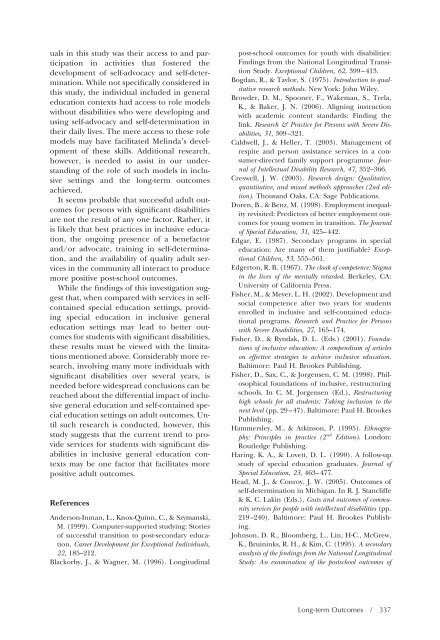Education and Training in Autism and Developmental Disabilities
Education and Training in Autism and Developmental Disabilities
Education and Training in Autism and Developmental Disabilities
Create successful ePaper yourself
Turn your PDF publications into a flip-book with our unique Google optimized e-Paper software.
uals <strong>in</strong> this study was their access to <strong>and</strong> participation<br />
<strong>in</strong> activities that fostered the<br />
development of self-advocacy <strong>and</strong> self-determ<strong>in</strong>ation.<br />
While not specifically considered <strong>in</strong><br />
this study, the <strong>in</strong>dividual <strong>in</strong>cluded <strong>in</strong> general<br />
education contexts had access to role models<br />
without disabilities who were develop<strong>in</strong>g <strong>and</strong><br />
us<strong>in</strong>g self-advocacy <strong>and</strong> self-determ<strong>in</strong>ation <strong>in</strong><br />
their daily lives. The mere access to these role<br />
models may have facilitated Mel<strong>in</strong>da’s development<br />
of these skills. Additional research,<br />
however, is needed to assist <strong>in</strong> our underst<strong>and</strong><strong>in</strong>g<br />
of the role of such models <strong>in</strong> <strong>in</strong>clusive<br />
sett<strong>in</strong>gs <strong>and</strong> the long-term outcomes<br />
achieved.<br />
It seems probable that successful adult outcomes<br />
for persons with significant disabilities<br />
are not the result of any one factor. Rather, it<br />
is likely that best practices <strong>in</strong> <strong>in</strong>clusive education,<br />
the ongo<strong>in</strong>g presence of a benefactor<br />
<strong>and</strong>/or advocate, tra<strong>in</strong><strong>in</strong>g <strong>in</strong> self-determ<strong>in</strong>ation,<br />
<strong>and</strong> the availability of quality adult services<br />
<strong>in</strong> the community all <strong>in</strong>teract to produce<br />
more positive post-school outcomes.<br />
While the f<strong>in</strong>d<strong>in</strong>gs of this <strong>in</strong>vestigation suggest<br />
that, when compared with services <strong>in</strong> selfconta<strong>in</strong>ed<br />
special education sett<strong>in</strong>gs, provid<strong>in</strong>g<br />
special education <strong>in</strong> <strong>in</strong>clusive general<br />
education sett<strong>in</strong>gs may lead to better outcomes<br />
for students with significant disabilities,<br />
these results must be viewed with the limitations<br />
mentioned above. Considerably more research,<br />
<strong>in</strong>volv<strong>in</strong>g many more <strong>in</strong>dividuals with<br />
significant disabilities over several years, is<br />
needed before widespread conclusions can be<br />
reached about the differential impact of <strong>in</strong>clusive<br />
general education <strong>and</strong> self-conta<strong>in</strong>ed special<br />
education sett<strong>in</strong>gs on adult outcomes. Until<br />
such research is conducted, however, this<br />
study suggests that the current trend to provide<br />
services for students with significant disabilities<br />
<strong>in</strong> <strong>in</strong>clusive general education contexts<br />
may be one factor that facilitates more<br />
positive adult outcomes.<br />
References<br />
Anderson-Inman, L., Knox-Qu<strong>in</strong>n, C., & Szymanski,<br />
M. (1999). Computer-supported study<strong>in</strong>g: Stories<br />
of successful transition to post-secondary education.<br />
Career Development for Exceptional Individuals,<br />
22, 185–212.<br />
Blackorby, J., & Wagner, M. (1996). Longitud<strong>in</strong>al<br />
post-school outcomes for youth with disabilities:<br />
F<strong>in</strong>d<strong>in</strong>gs from the National Longitud<strong>in</strong>al Transition<br />
Study. Exceptional Children, 62, 399–413.<br />
Bogdan, R., & Taylor, S. (1975). Introduction to qualitative<br />
research methods. New York: John Wiley.<br />
Browder, D. M., Spooner, F., Wakeman, S., Trela,<br />
K., & Baker, J. N. (2006). Align<strong>in</strong>g <strong>in</strong>struction<br />
with academic content st<strong>and</strong>ards: F<strong>in</strong>d<strong>in</strong>g the<br />
l<strong>in</strong>k. Research & Practice for Persons with Severe <strong>Disabilities</strong>,<br />
31, 309–321.<br />
Caldwell, J., & Heller, T. (2003). Management of<br />
respite <strong>and</strong> person assistance services <strong>in</strong> a consumer-directed<br />
family support programme. Journal<br />
of Intellectual Disability Research, 47, 352–366.<br />
Creswell, J. W. (2003). Research design: Qualitative,<br />
quantitative, <strong>and</strong> mixed methods approaches (2nd edition).<br />
Thous<strong>and</strong> Oaks, CA: Sage Publications.<br />
Doren, B., & Benz, M. (1998). Employment <strong>in</strong>equality<br />
revisited: Predictors of better employment outcomes<br />
for young women <strong>in</strong> transition. The Journal<br />
of Special <strong>Education</strong>, 31, 425–442.<br />
Edgar, E. (1987). Secondary programs <strong>in</strong> special<br />
education: Are many of them justifiable? Exceptional<br />
Children, 53, 555–561.<br />
Edgerton, R. B. (1967). The cloak of competence: Stigma<br />
<strong>in</strong> the lives of the mentally retarded. Berkeley, CA:<br />
University of California Press.<br />
Fisher, M., & Meyer, L. H. (2002). Development <strong>and</strong><br />
social competence after two years for students<br />
enrolled <strong>in</strong> <strong>in</strong>clusive <strong>and</strong> self-conta<strong>in</strong>ed educational<br />
programs. Research <strong>and</strong> Practice for Persons<br />
with Severe <strong>Disabilities</strong>, 27, 165–174.<br />
Fisher, D., & Ryndak, D. L. (Eds.) (2001). Foundations<br />
of <strong>in</strong>clusive education: A compendium of articles<br />
on effective strategies to achieve <strong>in</strong>clusive education.<br />
Baltimore: Paul H. Brookes Publish<strong>in</strong>g.<br />
Fisher, D., Sax, C., & Jorgensen, C. M. (1998). Philosophical<br />
foundations of <strong>in</strong>clusive, restructur<strong>in</strong>g<br />
schools. In C. M. Jorgensen (Ed.), Restructur<strong>in</strong>g<br />
high schools for all students: Tak<strong>in</strong>g <strong>in</strong>clusion to the<br />
next level (pp. 29–47). Baltimore: Paul H. Brookes<br />
Publish<strong>in</strong>g.<br />
Hammersley, M., & Atk<strong>in</strong>son, P. (1995). Ethnography:<br />
Pr<strong>in</strong>ciples <strong>in</strong> practice (2 nd Edition). London:<br />
Routledge Publish<strong>in</strong>g.<br />
Har<strong>in</strong>g, K. A., & Lovett, D. L. (1990). A follow-up<br />
study of special education graduates. Journal of<br />
Special <strong>Education</strong>, 23, 463–477.<br />
Head, M. J., & Conroy, J. W. (2005). Outcomes of<br />
self-determ<strong>in</strong>ation <strong>in</strong> Michigan. In R. J. Stancliffe<br />
& K. C. Lak<strong>in</strong> (Eds.), Costs <strong>and</strong> outcomes of community<br />
services for people with <strong>in</strong>tellectual disabilities (pp.<br />
219–240). Baltimore: Paul H. Brookes Publish<strong>in</strong>g.<br />
Johnson, D. R., Bloomberg, L., L<strong>in</strong>, H-C., McGrew,<br />
K., Bru<strong>in</strong><strong>in</strong>ks, R. H., & Kim, C. (1995). A secondary<br />
analysis of the f<strong>in</strong>d<strong>in</strong>gs from the National Longitud<strong>in</strong>al<br />
Study: An exam<strong>in</strong>ation of the postschool outcomes of<br />
Long-term Outcomes / 337

















